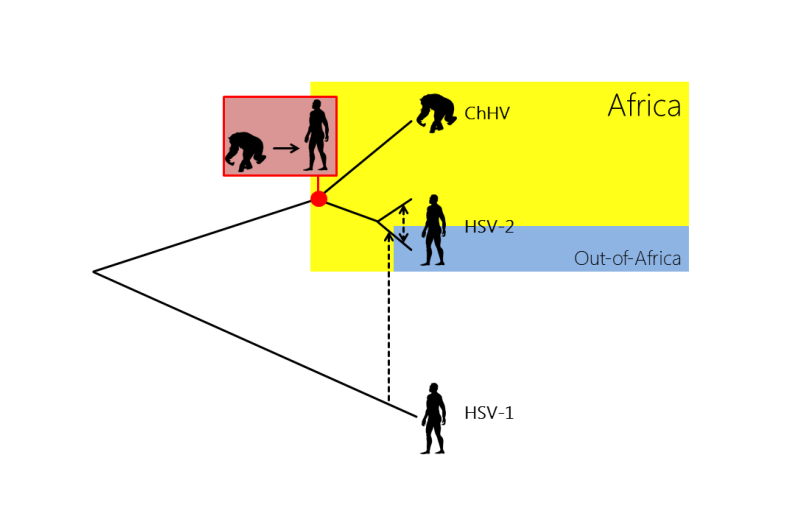Herpes STDs: From chimps to humans to cold sore cousin mixing before worldwide spread

It's an axiom of the infectious disease research community that wherever humans go, germs are likely to follow. Such is the case with the herpes virus family.
There are two main strains, herpes simplex virus 1 and 2 (HSV 1 and 2). HSV1 is mostly transmitted by mouth, and seen most often in the common cold sores (affecting two-thirds of the world's population). HSV-2 is the main culprit of genital herpes (global prevalence of 11 percent), but has even been used to help verify the accepted ancient migrations of humans "Out of Africa" dogma that began about 80,000-50,000 years ago.
Evolutionarily, Herpes simplex virus 1 and 2 are considered cousins, and are thought to have evolved independently, Now, an entirely new picture is emerging.
First, research team leader and corresponding author Sébastien Calvignac-Spencer wanted to build on prior work, which found a new variant of HSV-2 isolated only in sub-Saharan African individuals (they explored African populations because they have the highest prevalence of HSV-1 and 2 in the world). They wanted to expand their work by analyzing more of these HSV variants and compare their evolutionary divergence to each other.
"We had in mind a paper published by Joel Wertheim and colleagues in 2014 in Molecular Biology and Evolution," said Calvignac-Spencer. "They showed that HSV-2 was likely the result of a very old zoonotic transmission from the chimpanzee/bonobo lineage to the human one. We thought that maybe in these African HSV-2 samples, there would be recombinant traces of additional transfers. So we wanted to perform inclusive recombination analyses, using the single chimpanzee alpha herpes virus genome available as well as HSV-1 genomes."
Now, using the whole genome sequencing data of 18 HSV-2 isolates, Calvignac-Spencer and colleagues at Berlin's Robert Koch Institut and Paris' University Hospital La Pitié-Salpêtrière - Charles Foix have further explored the evolutionary history of the virus.
While they did not find evidence of chimpanzee herpes virus fragments in HSV-2 genomes, they show the history of HSV-2 was marked by recombination with HSV-1. In addition, they determined two main lineages of HSV-2, one globally distributed and another restricted to sub-Saharan Africa, which both started diversifying about 30,000 years ago (kya). The global HSV-2 shows evidence of ancient mixing with the HSV-1 virus, which through computational tools, they traced back to occurring between 34,000 - 95,000 thousand years ago (kya).
"Our results show that, contrary to common belief, mixed HSV-1/HSV-2 infections haveled to natural gene flow from HSV-1 into HSV-2 genomes," said Calvignac-Spencer. "This went unnoticed for a while even though all HSV-2 genomes published until our study included recombinant fragments. We were lucky enough that our sampling included the "untouched" African lineage and that our initial objective pushed us to also include HSV-1 genomes in recombination analyses."
"We propose a model of HSV-2 evolution in which, following a putative transmission from chimpanzees to the human lineage, HSV-2 diversified in African populations before a single lineage characterized by recombinant HSV-1 fragments (the worldwide lineage) accompanied the migration of Homo sapiens out of Africa. African HSV-2 belonging to the worldwide lineage may be the result of later contacts to non-African populations. Our results also pinpoint that HSV-1/HSV-2 co-infections occurring today may have some public health relevance."
Their findings appear in the advanced online edition of Molecular Biology and Evolution.
More information: Ancient recombination events between human herpes simplex viruses, Molecular Biology and Evolution, 2017.
Journal information: Molecular Biology and Evolution
Provided by Oxford University Press

















